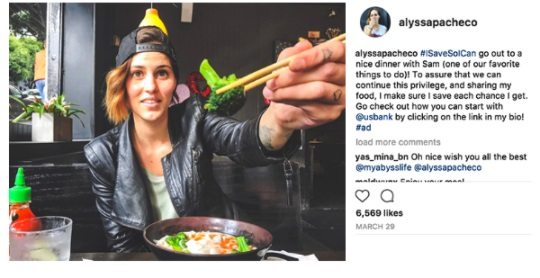How Banks Can Harness the Power of Social Influencers
Last week, I had the opportunity to speak at the American Banking Association’s Bank Marketing Conference held in New Orleans at the Hyatt Regency from September 24-26, 2017. The conference is held each year in a different location around the country, and is the flagship bank marketing conference for banks of all sizes all across the country to learn the latest marketing trends from industry experts.
I was asked to discuss how banks can harness the power of social influencers from the basics of influencer marketing to how financial institutions specifically can be working with influencers to create powerful marketing campaigns.
Influencer marketing is when a business partners with an individual who has an influential voice to tell their story. Whether it’s a professional athlete, a media personality, a blogger or just a person with a large social media following, influencers have the power to impact a consumer’s opinion or choice and connect with them in an authentic way on behalf of your brand.
How have financial organizations implemented influencer marketing?
American Express implemented a campaign on Instagram called #MyAmex, partnering with fashion influencers to have them take over their account and post content about how amex affects their businesses. The content allowed real card holders (with significant followings) to share relatable stories that built a more personal connection with people and broadened the American Express reach to a whole new audience. It resulted in millions of Instagram impressions in just two weeks. US Bank worked with influencers on the #ISaveSoICan campaign to raise awareness of what customers can accomplish when saving with them, and to send people to their website.

Both of these campaigns show how brands like a bank can work with influencers to share content that connects with people and makes the brand more human. They both also show you how influencers are content creators, meaning they are often taking the photographs or videos for your campaign, writing the copy and publishing the content. With traditional advertising, you would be hiring a different person for all of these factors in addition to the ad placement itself.

What’s the difference between traditional advertising and influencer marketing?
Like many digital marketing tactics, influencer marketing can be targeted more directly, and is more measurable upon completion of a campaign. If you put up a billboard for your business, there’s no way to really know how many people are going to drive by and see it, and who those people are. Whereas, influencers can tell you that their following is 70% women and 50% are between the ages 25-34 before you even decide to work with them. After the campaign they can provide you with data like how many people clicked on a link, or saw the content they posted about your brand.
The fact that the influencer is creating content for your brand offers a certain authenticity that traditional advertising does not, coming off like less of a sales pitch. The audience you are trying to reach already knows and trusts the influencer they are following before they talk about your brand.

What should an organization’s goals be?
The goal will be different for every business, and even from campaign to campaign. The great news is influencers can help in more ways than one. From raising awareness to growing your social media following or sending more people to your website, make sure your goal is clearly defined before choosing to work with influencers.
Working with influencers before you are ready can defeat the entire purpose of the campaign and be a waste of money and resources.
Once you determine that your brand is ready to work with influencers, and you have a clear understanding of what your goals are, it’s time to identify influencers, reach out to them and coordinate your campaign. This is the hardest step and takes a lot of time. If you work with a marketing or public relations agency, you should ask them if they have the capability to implement influencer campaigns for your company. If not, you should really have someone dedicated to this and not just take it on as a side project yourself.

Some examples of influencers that might be a good fit for banking organizations include mommy bloggers, financial bloggers, lifestyle influencers and even local entrepreneurs with large followings, but the possibilities are endless.
You can learn more about the power of social influencers by viewing my downloadable presentation here, or calling 504-324-0073 today!
